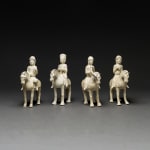Set of Four Sui Crème-Glazed Horses and Riders, 581 CE - 618 CE
Glazed Terracotta
height 21.6 cm
height 8 1/2 in
height 8 1/2 in
H.759
Further images
After almost four hundred years of civil war and division, Yang Jian succeeded in reunifying north and south under one authority, the Sui Dynasty. However, despite its brief duration, lasting...
After almost four hundred years of civil war and division, Yang Jian succeeded in reunifying north and south under one authority, the Sui Dynasty. However, despite its brief duration, lasting for the rule of only two emperors, the Sui Dynasty paved the way for the cultural renaissance that would arise during the T’ang Dynasty. Reforms were introduced to wrest power out of the hands of the aristocracy, military, and Buddhist communities. The Confucianist system of selecting government officials from state schools, by means of rigorous examinations, was initiated. Perhaps their most significant program was the construction of the Great Canal, a project that facilitated the movement of people and goods across great distances, aiding in the reunification of China. However, the cost of the Canal bankrupted the empire and ultimately led to its dissolution, coupled with a failed campaign to conquer Korea. The rulers of the T’ang would capitalize on the infrastructure improvements of the Sui and establish one of the greatest empires in the history of China, following the footsteps of the Sui.
This charming set of four horse and rider sculptures, covered in a crème glaze characteristic of the Sui Dynasty, depicts a procession of musicians and attendants. One rider bangs a drum that hangs off the side of his steed. Another blows on a long arching horn he carries in his hands. We can imagine the rhythmic tones of their music rising over the nose of the horses’ hooves hitting the ground. The other two riders appear to be attendants or court officials. This procession might have been a joyous occasion to entertain the crowd of onlookers while simultaneously demonstrating the resplendent wealth and power of the court. It is also possible that this procession was more somber occasion, leading to the burial place of a fallen leader. Discovered inside a tomb, this set clearly served an important purpose in the afterlife. We can imagine the deceased individual awaking in the next world to the tones of the musicians and the welcome of his official attendants. This gorgeous set of sculptures gives us a glimpse into the past, into the blossoming period of one of the great golden ages of human civilization.
This charming set of four horse and rider sculptures, covered in a crème glaze characteristic of the Sui Dynasty, depicts a procession of musicians and attendants. One rider bangs a drum that hangs off the side of his steed. Another blows on a long arching horn he carries in his hands. We can imagine the rhythmic tones of their music rising over the nose of the horses’ hooves hitting the ground. The other two riders appear to be attendants or court officials. This procession might have been a joyous occasion to entertain the crowd of onlookers while simultaneously demonstrating the resplendent wealth and power of the court. It is also possible that this procession was more somber occasion, leading to the burial place of a fallen leader. Discovered inside a tomb, this set clearly served an important purpose in the afterlife. We can imagine the deceased individual awaking in the next world to the tones of the musicians and the welcome of his official attendants. This gorgeous set of sculptures gives us a glimpse into the past, into the blossoming period of one of the great golden ages of human civilization.









